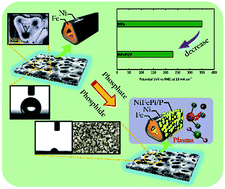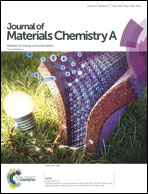Highly wettable and metallic NiFe-phosphate/phosphide catalyst synthesized by plasma for highly efficient oxygen evolution reaction†
Abstract
Many catalysts exhibit a high overpotential with a current density of 10 mA cm−2 for the oxygen evolution reaction (OER). High conductivity, wettability and active sites play key roles for a highly efficient OER catalyst. Here, we report a NiFe foam starting material treated with a two-step process using plasma-enhanced chemical vapor deposition (PECVD) in the presence of PH3, CO2 and H2, to form phosphate (Pi) and phosphide (P) groups on the foam, and forming NiFePi/P. The self-supported material combines conductivity, wettability with active sites, and is used directly as a working electrode for excellent oxygen evolution in alkaline solutions. Significantly, the strong synergistic effect between the phosphate and phosphide lead to a change in the surrounding electronic environment of metal ions that contributes to the increase in active sites, while improving the wettability and metallic nature of the catalyst, both of these result in an enhanced OER performance. This new material and design strategy appear to represent an intriguing advance that is likely to be of considerable interest to other researchers in the field.



 Please wait while we load your content...
Please wait while we load your content...